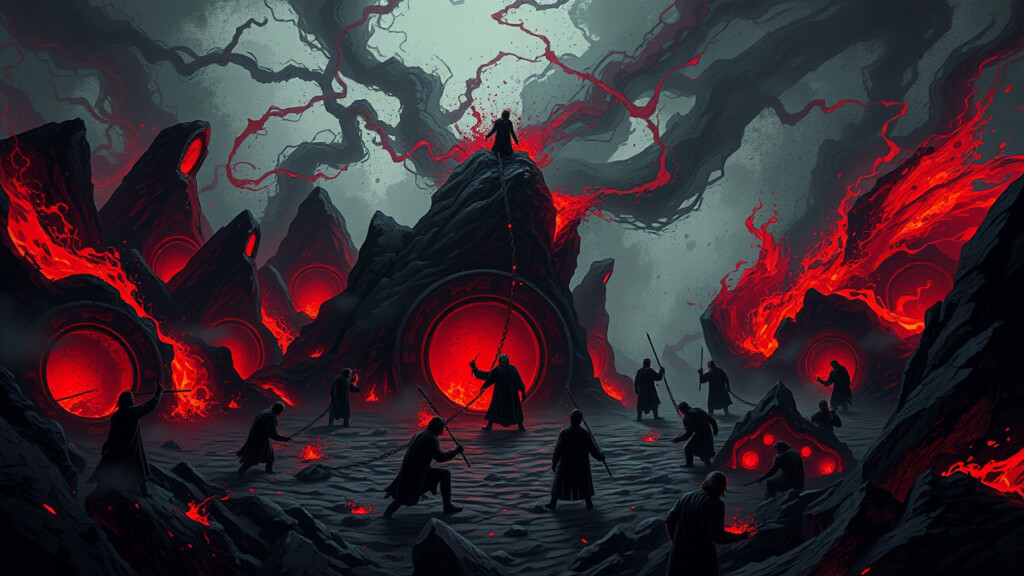From the moment humans became aware of good and evil, they created hell as a symbol of punishment, standing in contrast to paradise. More than just a fictional concept, hell has served as an invisible system of law across cultures and religions. In hell in different religions, whether in Christianity or Buddhism, hell remains a central idea tied to punishment and judgment.

However, each religion envisions hell differently. The Christian vs Buddhist hell debate highlights a fundamental contrast: Christianity sees hell as an eternal destination for sinners, whereas Buddhism treats it as a temporary stop where souls purge their karma before reincarnation. But how exactly does hell operate in the human imagination?
Hell in Christianity – Eternal Justice or Everlasting Fear?
In Christianity, hell is where souls face eternal punishment for rejecting faith or committing grave sins. According to the Bible, hell is not only a place of unquenchable fire (Mark 9:43) but also complete separation from God—a state of despair with no escape.
The imagery of Satan, the nine circles of hell, and gruesome punishments doesn’t originate from the Bible itself but from medieval literature, especially Dante’s Inferno. In this depiction, hell consists of nine descending layers, with Judas—the ultimate betrayer—forever devoured by Satan.
However, in some modern religious views on hell, the concept is no longer seen as a literal inferno but rather as a state of complete disconnection from God. Whether portrayed as physical torment or spiritual desolation, Christian hell remains a point of no return.
Hell in Buddhism – Path to Rebirth or Endless Suffering?
Unlike Christianity, Buddhism considers hell a phase within samsara, the cycle of birth, death, and rebirth. It is not a final destination but rather a temporary realm where souls atone for their past misdeeds. According to the Sutra of Ksitigarbha, Buddhist hell consists of 18 levels, each corresponding to a different sin.
Here, there is no Satan—only Yama, the King of Hell, along with his judges, who determine appropriate punishments. Common forms of suffering include:
- Liars having their tongues repeatedly cut out.
- Murderers being boiled alive in cauldrons of oil.
- The unfilial frozen until their bodies shatter into pieces.
Despite these horrors, afterlife punishment beliefs in Buddhism suggest that hell is not permanent. Once a soul has paid its karmic debt, it can be reborn—whether as a human or another form of existence.
Christian vs. Buddhist Hell – Which One is More Terrifying?
| Aspect | Christian Hell | Buddhist Hell |
|---|---|---|
| Nature | Eternal punishment for condemned souls. | A temporary karmic cleansing in samsara. |
| Duration | Forever, with no possibility of redemption. | Temporary, with the chance of reincarnation. |
| Ruler | Satan (popular depiction) or separation from God. | Yama and his court of judges. |
| Key Torments | Eternal fire, spiritual and physical suffering. | Tongue-cutting, dismemberment, boiling oil. |
| Number of Levels | No fixed number in the Bible, but Inferno describes nine circles. | 18 levels (as per Buddhist scriptures). |
| Escape Route | None. Once in hell, the soul is doomed forever. | Rebirth is possible after karma is repaid. |
The purpose of hell in faith differs between these traditions: Christianity sees it as the final judgment, while Buddhism treats it as a karmic checkpoint in the cycle of existence.
What Happens If We Stop Believing in Hell?
Even without religious hell, modern society has developed alternative systems of punishment:
- Liars who once had their tongues cut out now face career death over a single misleading tweet.
- Betrayers who were once thrown into an abyss can now be buried under a scandal overnight.
- The fear of eternal fire has been replaced by public shaming and online backlash.
Beyond social punishment, secular law serves as a modern version of hell. Life sentences, solitary confinement, and death penalties resemble religious hells—where offenders are isolated, punished, and cut off from redemption. Some notorious prisons, like ADX Florence in the U.S., confine inmates to 23 hours a day in solitude, evoking the deepest circle of hell.
Even as religious beliefs evolve, the fear of punishment never disappears—it simply transforms, shifting from divine judgment to social and legal consequences.
